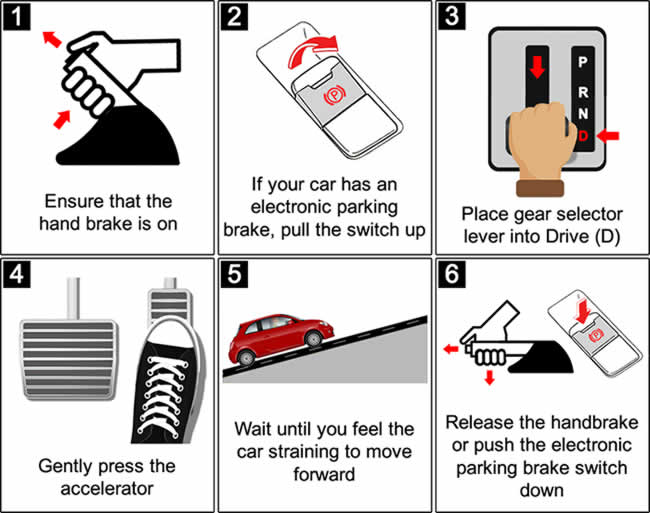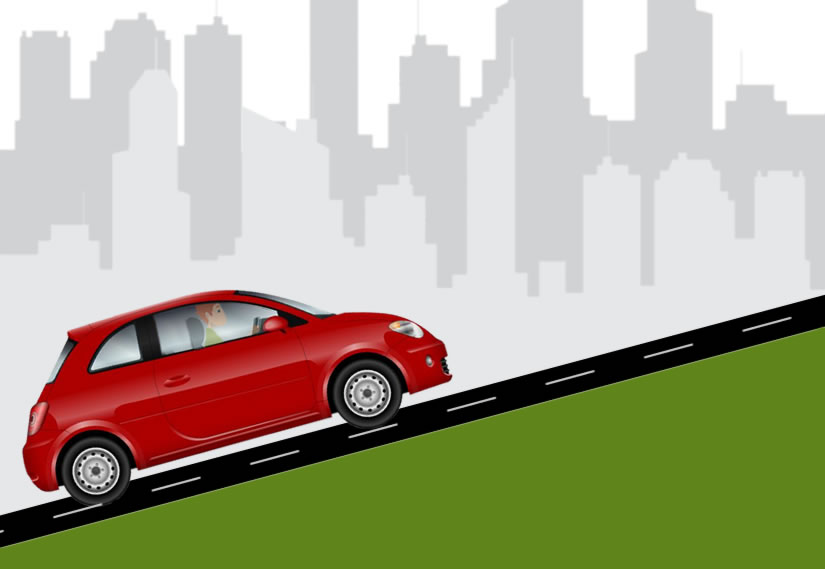Whether you’re learning to drive or have simply never attempted a hill start, but now find it a necessity to learn, you’ve come to the right place. This tutorial is going to explain how to do a hill start in an automatic car.
What is a Hill Start?
A hill start involves the driver moving their vehicle off from a stationary position either uphill or downhill.
Do You Have to do a Hill Start on your Driving Test?
Whether or not you do a hill start on your driving test simply comes down to location. If there are hills or inclines within the test route vicinity of the test centre, there’s a very good chance you’ll be asked to carry out a hill start during the driving test.
What Are the Problems Associated with Hill Starts?
Problems typically associated with an uphill start is the vehicle rolling backwards. This loss of control can result in a minor collision with the vehicle behind or may prove hazardous to other road users such as cyclists.
Is it Easier to do a Hill Start in an Automatic Car?
Yes, a hill start in an automatic car is much easier than a manual. In a manual car, you must use clutch control to prevent the vehicle from rolling backwards or stalling. In an automatic car, this process is done automatically for the driver meaning that you will not stall the vehicle, and you’re far less likely to roll backwards.
Can Automatic Cars Stall on a Hill?
Provided that the car is driven as designed to do so, then no, a modern automatic car will not stall. Of course there’s always the exception, but generally speaking, if a modern automatic car stalls, it’s an indication of a mechanical fault within the vehicle.
How to do a Hill Start in an Automatic Car
Use this technique to stop an automatic car from rolling backwards on a hill:

- Ensure that you car’s hand brake is on
- If your car has an electronic parking brake, pull the switch up
- Place the gear selector lever into Drive (D)
- Gently press the accelerator pedal
- When you feel the car straining to move forward
- Release the handbrake or electronic parking brake
This technique will prevent your automatic car from rolling backwards when moving off on a hill. If after releasing the handbrake / parking brake the car does not move forwards, apply a little more pressure to the accelerator.
As the car’s engine has to work harder to carry the weight of the car uphill, it needs more power and by applying more pressure to the accelerator pedal, the engine will more power to move uphill.
If your car does happen to roll backwards it’s important to gain control quickly, so either give the engine more power by pressing the accelerator pedal, or quickly and firmly press the brake pedal and try the process again.
Can an Automatic Car Roll Down a Hill?
Most modern automatic cars have a feature called ‘creep‘ that means they slowly creep forwards or backwards depending on whether a forward or reverse gear is selected. On a gently hill, the creep feature would be enough to prevent the car from rolling backwards.
However, on steeper hills, the car still roll backwards unless the driver increases the pressure on the accelerator pedal, therefore increasing engine power to move the car forwards.
Hill Start Assist
Almost all new cars either come with the hill start assist function, or have the option of having the feature at purchase. Hill start assist is on by default and aids the driver by holding the car stationary on an incline while they prepare for moving off.
Sensors in the car detect that the vehicle has stopped on an incline. Hill start assist will then automatically apply the enough pressure on the brakes to prevent the vehicle from rolling backwards. In most cars, the brakes are automatically applied for 2 to 3 seconds (enough time for the driver to get the car moving off), or until the accelerator pedal is pressed.
If after 2 or 3 seconds (this varies a little depending on the car manufacturer) you haven’t managed to get the car moving, hill start assist will release the brakes and the car will roll backwards. In this instance, you’ll need to quickly press the brake pedal, apply the parking brake and start again.
Can I use Hill Start Assist in the Driving Test?
Yes, driving test examiners allow the use of hill start assist, there’s no need to deactivate it.
Which Gear is Best for Driving Uphill in Automatic Car?
You would generally leave the transmission in Drive (D) and let the car choose the most appropriate gear for the situation. Most modern automatic transmissions are capable for most situations.
Downhill Starts
The driving test may also involve you having to demonstrate a downhill start. If the hill is quite long and steep, you’ll need to learn the correct procedure for keeping the car slow, while not overheating the brakes. For further information, see downhill starts in an automatic car.
Tips for Private Practice
![]() If you’re giving a learner driver private practice, read up on our tips for teaching hills starts, downhill starts and driving downhill in an automatic car.
If you’re giving a learner driver private practice, read up on our tips for teaching hills starts, downhill starts and driving downhill in an automatic car.
